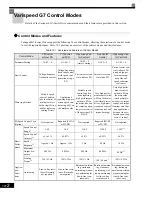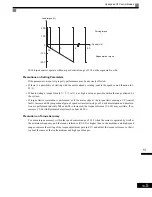
9
-4
Common Specifications
The following specifications apply to both 200-240 V and 380-480 V Class Drives.
* 1. Rotational autotuning must be performed to ensure obtaining the specifications given for flux vector control and open-loop vector control 1 and 2.
* 2. When connecting a Braking Resistor or Braking Resistor Unit, set L3-04 (Stall prevention selection during deceleration) to 0 (disabled). Stopping may not be pos-
sible in the specified deceleration time if this function is not disabled.
* 3. The maximum output frequency for open-loop vector control 2 is 60 Hz.
Table 9.3 Common Specifications
Model Number
CIMR-G7U
Specification
Control method
Sine wave PWM
Flux vector control, open-loop vector control 1 or 2, V/f control without PG, V/f control with PG (switched by parameter setting)
Torque characteristics
150%/0.3 Hz (Open-loop vector control 2), 150%/0 min
1
(Flux vector control)
*1
Speed control range
1:200 (Open-loop vector control 2), 1:1000 (Flux vector control)
*1
Speed control accuracy
±0.2% (Open-loop vector control, 25
C ± 10
C), ±0.02% (Flux vector control, 25
C ± 10
C)
Speed control response
10 Hz (Open-loop vector control 2), 30 Hz (Flux vector control)
Torque limits
Provided for vector control only (4 quadrant steps can be changed by parameter settings.)
Torque accuracy
5%
Frequency control range
0.01 to 400 Hz
*3
Frequency accuracy (tem-
perature characteristics)
Digital references: ± 0.01% (-10
C to +40
C)
Analog references: ±0.1% (25
C ±10
C)
Frequency setting resolu-
tion
Digital references: 0.01 Hz, Analog references: 0.03 Hz/60 Hz (11 bit with no sign)
Output frequency resolu-
tion
0.001 Hz
Overload capacity and
maximum current
*2
150% of rated output current per minute, 200% for 5 s
Frequency setting signal
-10 to 10 V, 0 to 10 V, 4 to 20 mA, pulse train
Acceleration/Decelera-
tion time
0.01 to 6000.0 s (4 selectable combinations of independent acceleration and deceleration settings)
Braking torque
Approximately 20% (Approximately 125% with Braking Resistor option, braking transformer built into 200-240 V and 380-480
V Class Drives for 15 kW or less.)
*2
Main control functions
Restarting for momentary power loss, speed searches, overtorque detection, torque limits, 17-speed control (maximum), accelera-
tion/deceleration time changes, S-curve acceleration/deceleration, 3-wire sequence, autotuning (rotational or stationary), dwell
functions, cooling fan ON/OFF control, slip compensation, torque compensation, jump frequencies, upper and lower limits for
frequency references, DC braking for starting and stopping, high-slip braking, PID control (with sleep function), energy-saving
control, MODBUS communications (RS-485/422, 19.2 kbps maximum), fault reset, function copying, droop control, torque con-
trol, speed/torque control switching, etc.
Motor protection
UL recognized protection by electronic thermal overload relay.
Instantaneous overcurrent
protection
Stops at approx. 200% of rated output current.
Fuse blown protection
Stops for fuse blown.
Overload protection
150% of rated output current per minute, 200% for 5 s
Overvoltage protection
200-240 Class Drive: Stops when main-circuit DC voltage is above 410 V.
380-480 Class Drive: Stops when main-circuit DC voltage is above 820 V.
Undervoltage protection
200-240 Class Drive: Stops when main-circuit DC voltage is below 190 V.
380-480 Class Drive: Stops when main-circuit DC voltage is below 380 V.
Momentary power loss
ridethrough
Stops for 15ms or more.
By selecting the momentary power loss method, operation can be continued if power is restored within 2 s.
Cooling fin overheating
Protection by thermistor.
Stall prevention
Stall prevention during acceleration, deceleration, or running.
Grounding protection
Protection by electronic circuits.
Charge indicator
Lit when the main circuit DC voltage is approx. 50 V or more.
Ambient operating tem-
perature
-10
C to 40
C (Enclosed wall-mounted type)
10
C to 45
C (Open chassis type)
Ambient operating humid-
ity
95% max. (with no condensation)
Storage temperature
- 20
C to + 60
C (short-term temperature during transportation)
Application site
Indoor (no corrosive gas, dust, etc.)
Altitude
1000 m max.
Vibration
Tolerance for vibration frequency less than 20 Hz, 9.8 m/s
2
max.; 20 to 50 Hz, 2 m/s
2
max
C
ont
ro
l c
ha
rac
te
ri
stic
s
Prot
ecti
ve functi
ons
En
vironm
ent
Summary of Contents for CIMR-G7U
Page 2: ......
Page 7: ...v...
Page 32: ...1 18...
Page 90: ...3 16...
Page 112: ...4 22...
Page 382: ...6 164...
Page 410: ...7 28...
Page 454: ......
Page 455: ......
















































